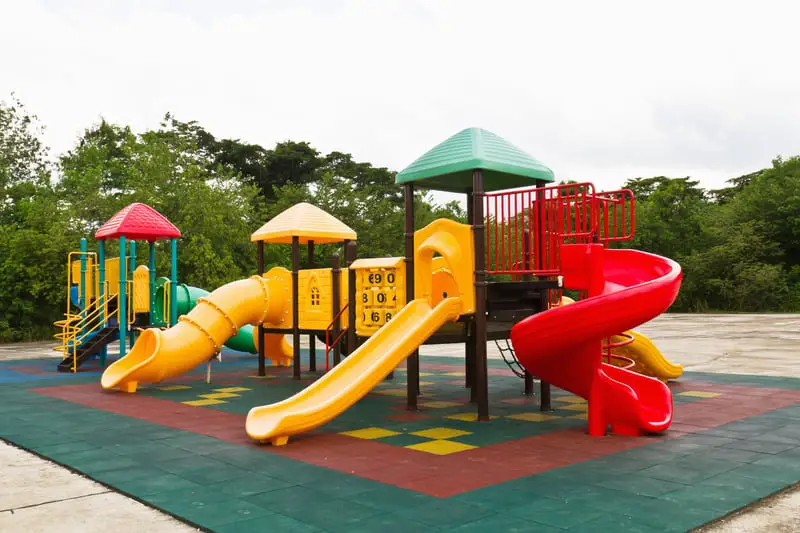When deciding on the best surface material for an outdoor playground, there are several factors to consider. If it’s a public playground or commercial playground, you’ll want to know what requirements need to be met to keep the children playing on it safe and to ensure that the surface materials are up to code.
When installing your own backyard playground equipment, you should consider safety, installation cost, installation difficulty, maintenance costs, and cleanliness.
As a parent, you’re concerned with your children’s safety. According to the U.S. Consumer Product Safety Commission Handbook for Public Playground Safety, which identifies public playground safety standards, falls are the most likely playground hazard. Maximizing the safety of your children’s play area begins with selecting the proper surface material.
Critical Height Rating
The CPSC assigns a critical height rating for each type of surface material. This rating approximates the highest fall that’s unlikely to cause a life-threatening head injury. Each manufacturer should provide you with the critical height rating of their materials. You should ensure the highest play surface on any equipment you install is lower than the critical height for the surface material you choose. This will help to reduce playground injuries and help you avoid a trip to the emergency room.
Material Types
When selecting playground surface material, you have several options. These fall into one of two categories: unitary surface materials, such as rubber mats and rubber tiles, are low maintenance but can be more expensive. Loose fill materials, such as engineered wood fiber, mulch, gravel, and sand, can be cheaper but require maintenance. Never place concrete, asphalt, or other hard surfaces under playground equipment, as falls onto these surfaces can lead to serious injuries.
Let’s we’ll explore the following common surface materials you might consider for your backyard playground.
- Unitary Materials
- Bare Ground
- Natural Grass
- Poured Rubber & Rubber Tiles
- Artificial Grass or Synthetic Turf
- Loose-fill Materials
- Sand
- Pea Gravel
- Mulch or Wood Chips
- Engineered Wood Fiber (EWF)
- Rubber Mulch
Unitary Surface Materials For Outdoor Playgrounds
Bare Ground
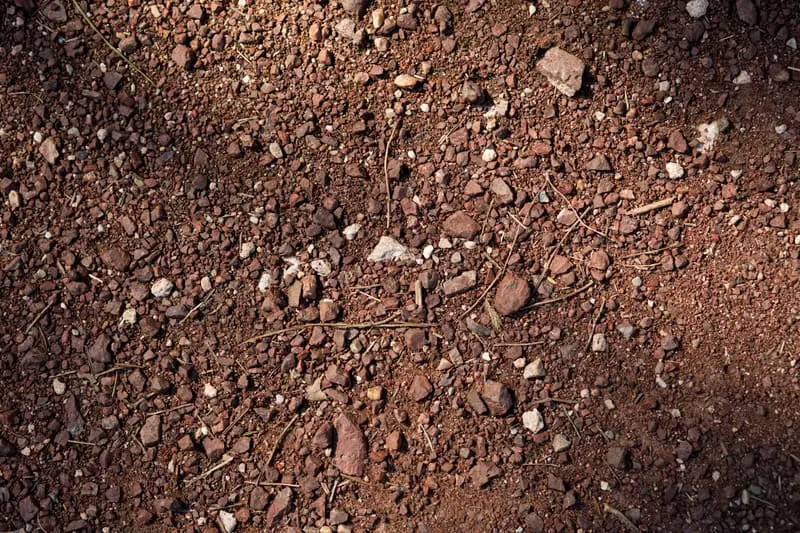
Bare earth is rarely anyone’s first choice as a good playground surface material. It is, however, something to consider if you have limited options or resources. Those who choose grass as their playground surface often end up with bare ground when wear and tear causes the grass around the playground equipment to die.
Safety – CPSC and NRPA also list bare ground as an improper playground surface. A fall from any height onto bare ground is liable to cause injury; thus, putting your play set on bare ground should be avoided whenever possible.
Cost and Maintenance – Bare ground requires no regular maintenance or upfront installation costs. But, when it rains, bare ground turns into mud, which your children can track around the yard and into the house.
Bare Ground Pros & Cons
Natural Grass
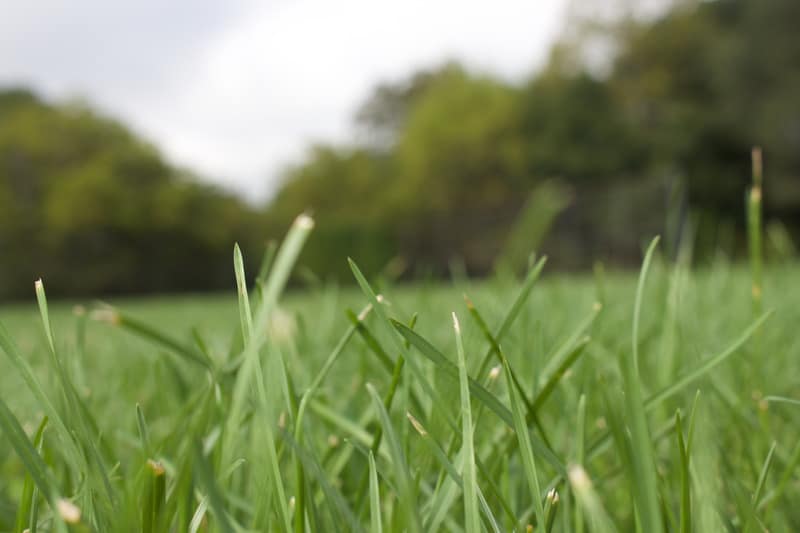
It’s common to place backyard playsets on existing grass. While this option requires minimal upfront cost and no surface installation, grass is usually not the best choice.
Safety – Grass is softer than bare ground or concrete, but it’s not a very good cushion. The Consumer Product Safety Commission and the National Recreation and Park Association (NRPA) both list grass as an inappropriate playground surface.
Cost and Maintenance – At first glance, you may not consider cost and maintenance as factors when using existing grass under a playset. However, there are some issues that you’re sure to run into when putting this option into practice.
First, the playground equipment will make it harder to care for the grass. Mowing the lawn will be more difficult, plus you’re likely to get extra wear and tear around the equipment if your kids use it regularly.
Second, you’re likely to find yourself trying to revive the grass around the playset to get rid of bald spots on the lawn. This will cost time and money.
Unforeseen Consequences – It’s almost impossible to keep your new playground equipment from getting wet on a regular basis when watering your grass. While most playground equipment is water-resistant, getting your play set wet every day or a few times a week can eventually cause rust or rot.
Grass Pros & Cons
Poured Rubber & Rubber Tiles
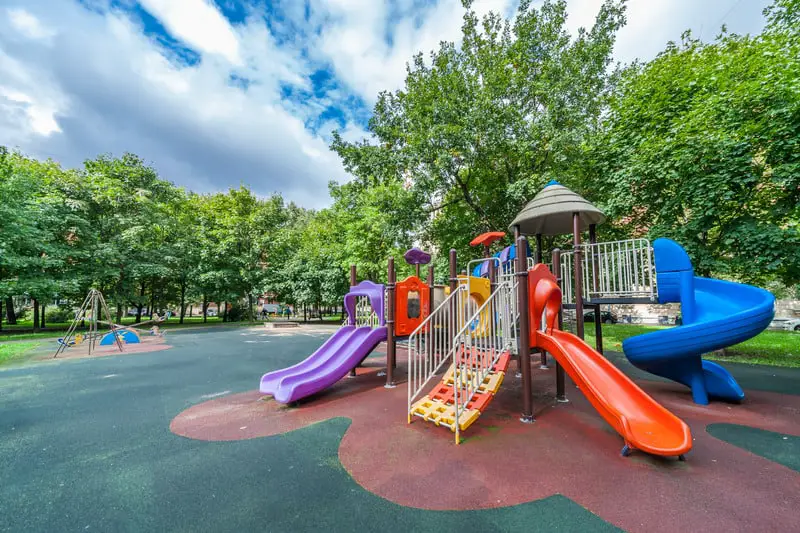
There is much to be said for low-maintenance, shock-absorbing rubber surfaces, whether poured in place or installed as rubber tiles. The safety and maintenance of both materials are similar, while costs can vary.
Safety – Poured-in-place rubber and rubber tiles both provide excellent shock absorption for all kinds of different playgrounds and swing sets. They don’t shift around like pea gravel, sand, or wood chips and so provide constant, even protection for your children.
Some rubber has harmful chemicals that are released when heated, so it’s best to verify the safety of the materials that you choose if you go this route.
Cost and Maintenance – Poured rubber is expensive since it requires professional installation. Depending on the project, it can range anywhere from $1,800 to $3,500.
Rubber tiles don’t require professional installation, as they are usually interlocking and easy to put together. However, they do require a smooth, flat surface on which to rest. On average, rubber tiles run anywhere from $5 to $20 per square foot.
Both options are low-maintenance, requiring only occasional upkeep in the form of sweeping or washing to keep clean. Otherwise, they last a very long time and don’t need replenishment like loose-fill options. They also tend to keep away insects, mold, and germs when regularly cleaned.
Poured Rubber & Rubber Tiles Pros & Cons
Artificial Grass or Synthetic Turf
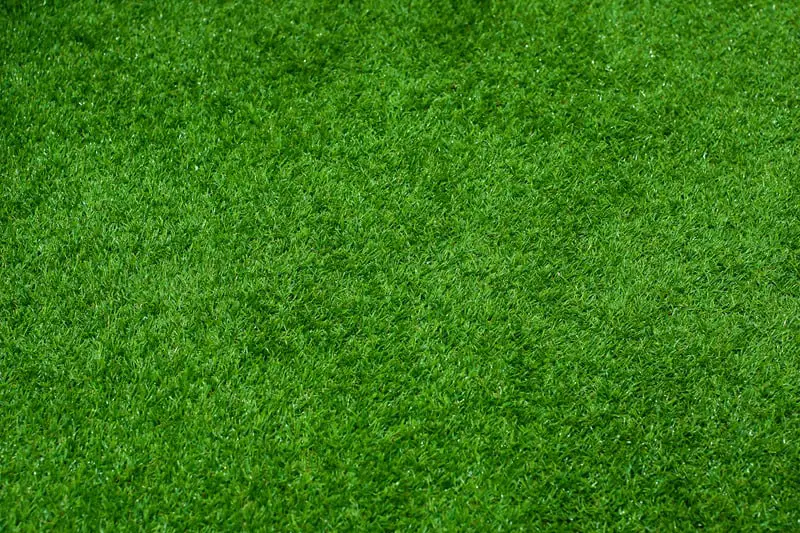
Artificial grass and turf are not themselves protective of falls. At their most basic, they’re sold unpadded or lightly padded. For fall protection, you will have to install padding underneath the artificial grass or turf, and you may need to replace the padding before the turf wears out.
Safety – Artificial turf can provide excellent fall absorption when sufficiently padded. It is wheelchair accessible, remains clean with regular maintenance, and doesn’t become slippery when wet. Some artificial turf, particularly in darker colors, can get hot in direct sunlight, which can cause burns. Installing it in a shady spot or spraying it down with water can help keep it cool in the summer months.
Cost and Maintenance – One of the more expensive playground material options, artificial grass runs anywhere from $3 to $10 per square foot. The thicker the padding, the more expensive it tends to be. But, it doesn’t need much maintenance other than sweeping or cleaning with water. You may have to replace the padding underneath, but not until after years of use.
Artificial Grass or Synthetic Turf Pros & Cons
Loose-fill Surface Materials For Outdoor Playgrounds
Sand
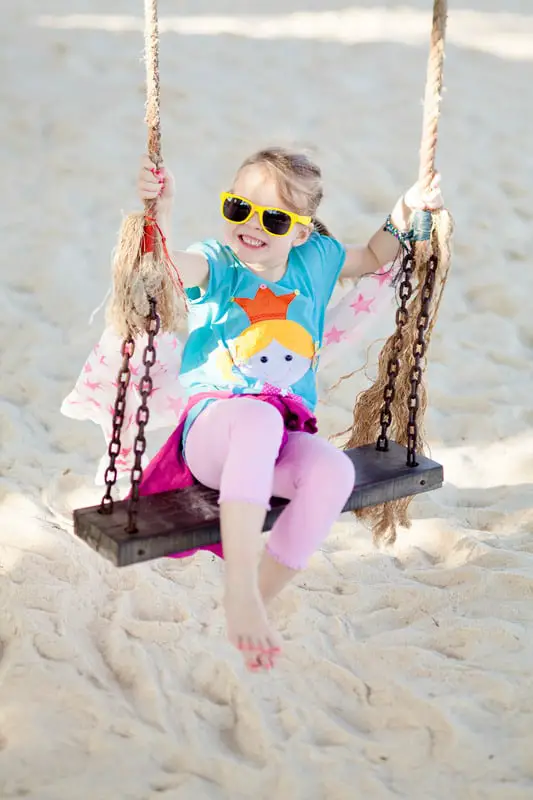
You can still find sand in a few public parks around the country, but it offers few benefits when compared to other options available today.
Safety – CSPC and NRPA list sand as an acceptable surface. It should provide a critical fall height of up to four feet when installed at a depth of 12 inches or more. It protects against falling injuries better than grass or bare earth. But, it can still become hard-packed and jarring for a child to land on, particularly when the ground freezes.
It’s not a choking hazard for children under 5 but can contain insects, animal waste, and microbial organisms.
Cost and Maintenance – Sand is one of the more affordable options at between $0.50 to $1.50 per square foot. You need to maintain it at 12” of depth for best results, which means regular raking or shoveling to even it out. It’s also important to have proper drainage to avoid standing water, which can cause the sand to become compacted and lose its shock-absorbing properties. Sand should also be checked regularly for foreign objects that can cause injuries.
Unforeseen Consequences – Sand can end up in shoes, pockets, and hair and can become stuck to the skin. This means sand can end up in your house after the kids play on the playground.
Sand Pros & Cons
Pea Gravel

More popular and less problematic than sand, pea gravel is cheap and easy to install. It has many pros but a few important cons to note when considering these pea-sized rocks for your playground material.
Safety – CSPC and NRPA consider pea gravel an acceptable material for playground and swing set areas. Like sand, it should be maintained at 12 inches deep for effective cushioning, where it can provide a critical fall height of up to five feet. But unlike sand, it can pose a choking hazard for children 5 and under. Animals, insects, and microbial organisms tend to stay away from pea gravel, making it a safer option for older children than sand, grass, and bare ground.
Cost and Maintenance – One of the most affordable materials for playground areas, pea gravel can usually be found for between $1 and $3 per square foot. It facilitates drainage and tends to settle less than sand. However, it does require regular maintenance to maintain the recommended 12” depth.
Pea Gravel Pros & Cons
Mulch and Wood Chips
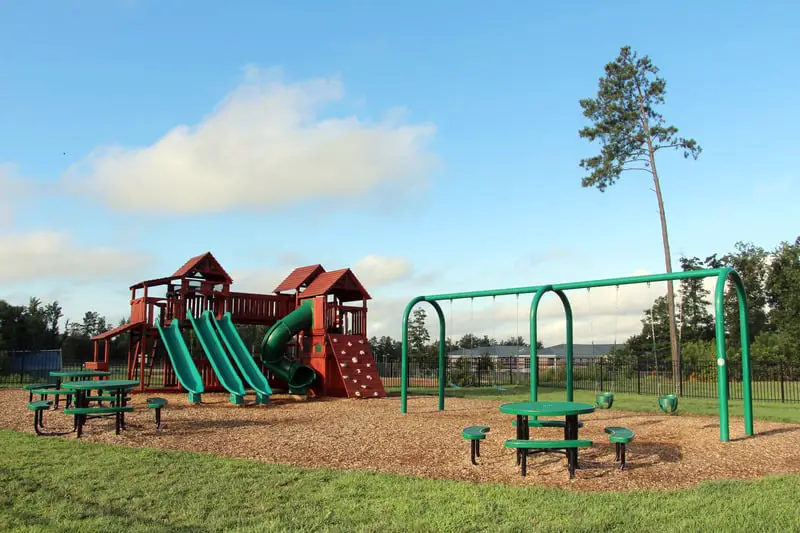
Small public playgrounds commonly use wood chips or wood mulch. These materials have a few benefits, but overall, the drawbacks make them a poor choice as playground surface materials.
Safety – One of the main benefits of wood chips is shock absorption. At the recommended depth of 12” or more, wood chips can create quite a soft surface, allowing for a critical fall height of up to ten feet. The critical fall height for 12″ of wood mulch is up to seven feet.
Wood chips and mulch pose a choking hazard for children under 5. In addition, fresh, untreated wood has a tendency to mold when wet. Treated wood may contain harmful chemicals such as chromated copper arsenate (CCA) that it’s best to keep your children away from.
Cost and Maintenance – Wood chips tend to cost less than other options, such as Engineered Wood Fiber and rubber mulch, while they are more expensive than pea gravel and sand. Expect to pay more for high-quality wood chips with no foreign objects and no chemicals. For good quality, non-CCA wood chips, you should expect to pay somewhere between $2 and $5 per square foot.
Maintaining wood chips or wood mulch as your playground material can be a bit of an ordeal. Since the chips tend to be lighter and easier to kick around than pea gravel or sand, they tend to end up outside of the play area’s border. So, if you have a lawn surrounding your playground, expect to find lots of wood chips in the grass after play sessions.
Wood Chips and Mulch Pros & Cons
Engineered Wood Fiber (EWF)
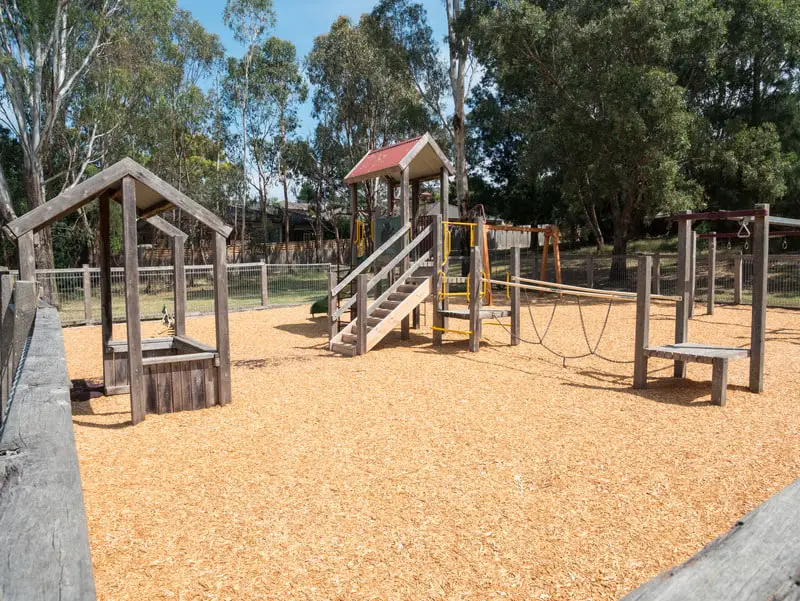
Engineered Wood Fiber (EWF) looks and functions like landscaping mulch. However, EWF is designed for use around and under playground equipment. Unfortunately, it shares many of the disadvantages of wood chips, making it only slightly better for playground material.
Safety – EWF provides great shock absorption, allowing a critical height of up to twelve feet when installed to 12″ and maintained. It is also slip-resistant and made of sustainably forested wood if bought from a reputable supplier. It can still pose a choking hazard for small children and can hide foreign objects and insects. If you decide to use EWF, you’ll want to check with your supplier to make sure they don’t use harmful chemicals to bind the fibers together.
Cost and Maintenance – Engineered Wood Fiber is generally more expensive than wood chips, mulch, sand, and pea gravel, particularly if you’re getting a high-quality, sustainably sourced product. It can sell anywhere from $3 to $7 per square foot.
EWF tends to stay in place better than wood chips, but since it’s a soft, natural product, it needs replacing on a regular basis. It also requires regular work to maintain a safe depth in all areas of the playground.
Engineered Wood Fiber Pros & Cons
Rubber Mulch

Rubber mulch is often made out of recycled rubber products such as tires. Using recycled material is good for the environment, but recycled tire rubber often contains harmful chemicals and carcinogens. You may want to make sure that the rubber mulch you’re thinking of purchasing is free from harmful chemicals. Otherwise, it’s a great shock absorber, and it’s easy to install.
Safety – Rubber mulch makes a great shock absorber. It has a critical height of ten feet with only a 6″ fill depth because it doesn’t compress in the same way that other loose-fill materials do. It can, however, pose a choking hazard to small children. It may also contain chemicals with unknown long-term effects. It will often smell strange when it heats up in the sun, as well.
Cost and Maintenance – Rubber mulch is usually slightly cheaper than poured rubber mats and rubber tiles. It’s also a more expensive option when compared to materials such as pea gravel and sand. It sells for around $11 per 2 cubic feet. Luckily, rubber doesn’t degrade easily, so you won’t need to replenish it often, if at all. You will want to regularly check it for foreign objects and to make sure it’s evenly distributed around the playground.
Rubber Mulch Pros & Cons
In Conclusion
As you can see, there are lots of different playground surfacing options. Finding the right one comes down to your budget, personal preference, and what you think is best for the safety of your little ones. A little more money upfront could help reduce the potential for injury to your child in the event of an accidental fall.
Playgrounds and swing sets have some risks involved, no matter what surface is underneath. But by choosing the best surface material for your outdoor playground, you can greatly reduce the chances of your child getting hurt.

